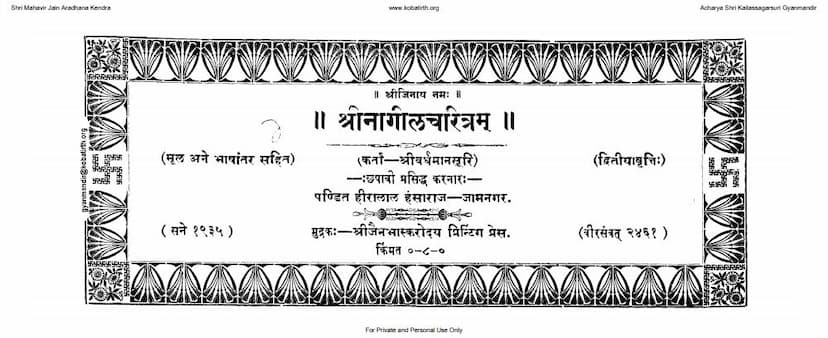Nagil Charitram
Added to library: September 2, 2025

Summary
Here is a comprehensive summary of the Jain text "Nagil Charitram" by Vardhamansuri, based on the provided text:
Book Title: Nagil Charitram (The Story of Nagil) Author: Acharya Shri Vardhamansuri Publisher: Shravak Hiralal Hansraj (Jamnagar) Translation and Publication: Pandit Shravak Hiralal Hansraj Edition: Second Edition Year of Publication: 1935 (Vir Samvat 2461)
Overall Theme: The "Nagil Charitram" is a Jain narrative that beautifully illustrates the importance and efficacy of celibacy (Brahmacharya Vrata), particularly the fourth minor vow (Chaturth Anuvrata) for householders, which emphasizes contentment with one's own spouse and abstaining from adultery. The story highlights how adherence to this vow, even in challenging circumstances, can lead to spiritual progress, purity, and ultimately, liberation.
Key Characters and Setting:
- Nagil: The central male protagonist, initially a gambler (kitav), who is attracted to wealth and sensual pleasures.
- Nanda: The virtuous and wise daughter of a wealthy merchant, Lakshman. She is characterized by her devotion to Tirthankaras, intelligence, humility, and unwavering adherence to Jain principles.
- Lakshman: Nanda's father, a prosperous merchant of Mahapur city, who is devoted to Jinendra (Tirthankaras).
- Virupaksha Yaksha: A Yaksha (celestial being) who grants boons.
- Leelavati: A celestial maiden (Vidyadhari), daughter of Chand, a king of Vidyadharas, who possesses magical powers and is initially driven by lust and anger.
Plot Summary:
-
Nanda's Vow: The story begins by describing the virtue of Brahmacharya. Nanda, a virtuous young woman, expresses a unique desire to her father: she wishes to marry a man who can maintain a lamp that burns without oil, wick, or soot – a metaphor for a pure and unwavering mind, free from attachments and impurities. Her father, Lakshman, is distressed as no one can fulfill this condition.
-
Nagil's Deception and the Yaksha's Boon: Nagil, a cunning gambler, overhears Nanda's condition. He approaches the Yaksha Virupaksha, who is pleased by his devotion and grants him a boon. Nagil requests to be able to create such a lamp. The Yaksha grants him the ability to create a miraculous lamp in his home, which appears to be the one Nanda desires.
-
The Marriage and Nagil's Continued Vice: Nagil, using this deceptive lamp, convinces Lakshman that he can fulfill Nanda's vow. The wealthy merchant, delighted, arranges the marriage. Despite being married to the virtuous Nanda, Nagil continues his gambling habits, losing wealth. Lakshman, out of love for his daughter, repeatedly replenishes Nagil's losses.
-
Nanda's Wisdom and Nagil's Doubt: Nanda, though dutifully serving Nagil, ponders why he doesn't get angry despite her perceived failings. She suspects Nagil's outward virtue is a facade.
-
Encounter with the Monk and Revelation: One day, Nagil, fleeing from his gambling debts, encounters a Jain monk. He confesses his doubts about Nanda's affection. The monk explains Nanda's vow: the lamp represented a mind free from the "soot" of passion (kashaya), the "oil" of attachment, and the "wick" of ego. Her wish was for a husband with a pure mind, embodying these qualities. The "lamp" she desired was a metaphor for the ideal Jain householder, not a literal lamp.
-
Nagil's Transformation: Nagil realizes his deception and the true meaning of Nanda's vow. He understands that Nanda wanted a man of true virtue, not a trickster. He sincerely accepts the monk's teachings, embraces the vow of contentment with his own wife (Swadar Santosh), and vows to abandon his vices.
-
Leelavati's Temptation and Nagil's Steadfastness: Later, while Nanda is visiting her parents, a celestial maiden named Leelavati, smitten by Nagil's appearance, attempts to seduce him. She possesses magical powers and threatens him with a heated iron ball. Nagil, firm in his commitment and remembering the monk's teachings, remains steadfast. He invokes the Navkar Mantra, which protects him from Leelavati's attack and causes her to retreat in shame.
-
Nanda's Return and Nagil's Test: Nanda returns home, and Nagil, still wary of deception, tests her by asking if she is indeed Nanda. When she confirms her identity, he is relieved and happy. He realizes Nanda's true nature and his own past foolishness.
-
Acceptance of True Celibacy and Renunciation: Moved by Nanda's virtue and his own experience, Nagil takes a vow of charitra (asceticism) from his guardian deity. He then approaches Nanda in the guise of a monk. He confesses his deception to the Yaksha and his realization of true virtue. The "lamp" itself speaks, confirming that it will continue to serve him without causing harm, like the sun's rays.
-
Life of Virtue and Spiritual Attainment: United in true virtue and love, Nagil and Nanda live a life of righteousness, engaging in charitable acts, devotion, and spiritual practices. Nagil, with Nanda's support and his own diligent study, quickly attains profound knowledge.
-
Birth and Liberation: Due to his past karma, Nagil's lifespan was predetermined. After completing his vows and living a virtuous life, he dies and is reborn in the Harivarsha continent under a Kalpavriksha tree as a Yukalika. After enjoying celestial pleasures, he and Nanda are both reborn in Mahavideha Kshetra and attain liberation (Moksha).
Moral of the Story:
The "Nagil Charitram" emphasizes that:
- True virtue is internal and spiritual, not just outward show or trickery.
- The vow of Brahmacharya, characterized by contentment with one's spouse and abstaining from adultery, is a powerful path to spiritual purity and progress.
- Adherence to Jain vows, even in the face of temptation and deception, leads to positive karma and spiritual growth.
- The power of faith, devotion, and the remembrance of sacred mantras (like the Navkar Mantra) can overcome obstacles and negative influences.
- True happiness and fulfillment come from a life of righteousness and spiritual discipline.
The story serves as an encouragement for individuals to diligently observe the vows of Jainism, particularly the fourth vow, leading to a virtuous life and eventual liberation.